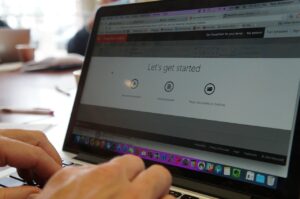The Danger of Remote Work
A few weeks ago, a good friend told us that after six months of remote work at home during spring’s lockdown phase of life and the nervousness that followed, she will be there forever. The reason: her employer (a nationwide company) is closing most of its offices.
The one in our area will remain for now, although there won’t be a receptionist. One can imagine the break room will soon look like a ghost town.
People who don’t want to work at home, don’t own a computer, or who want the socialization of an office can still come to the building.
But since most new hires will be required to work from home, one can imagine that office won’t be brimming with activity.
Drawbacks to Isolation

Yet, I see a number of drawbacks to its widespread adoption:
- A depression in commercial real estate.
If fewer and fewer people are going to the office, vacancy rates will mushroom, leaving desolate downtowns and office parks. I wonder what will happen to all those skyscrapers and other large spaces.
In our area, the school board is reviewing a proposal to move the high school vocational technical center to a vacant Sears store (which closed a year ago) at the local mall.
The space has the high ceilings and square footage badly needed by the vo-tech center, but I don’t see school expansions as a long-term solution for vacant real estate across the nation.
- A corresponding decline in restaurants.
If locally owned eateries (not to mention their larger chain counterparts) weren’t in enough trouble from the pandemic, imagine what more workers staying away from the office will do to flagging businesses.
The losses will be severe and rob many areas of the panache and uniqueness local restaurants offer.
When we visited Gettysburg, Pennsylvania five years ago, our first meal was at a chain restaurant close to our hotel. It was getting late, so simplicity and hunger won out over a desire to explore.
However, from that point on, we ate only at local restaurants. One was a rathskeller where we ate by candlelight, seated close to other patrons in a now-fond memory of the pre-social distancing era.
Others we stopped at were good enough to make us contemplate returning to see more of the sights we didn’t have time for—and the other restaurants we couldn’t visit. Or maybe return to some of the same ones.
- Increasing social isolation.

Instead of more understanding and less stereotyping of other races and cultures, I see more engaging in stereotyping, hostility, and ignorant judgments of others than in the past.
I think one reason for this sad drift is a number people will blast away at those they can’t see. Folks wouldn’t dream of saying the same thing to another’s face, if only because they fear a good swat on the kisser.
As one who finds Zoom a convenient tool that has enabled me to “meet” lately with people from places like Australia, South Africa, and Cincinnati, I’m not saying all technology is bad.
Still, we need to remember that we desperately need the presence of other people in our lives. High touch wins out over high tech every time.


